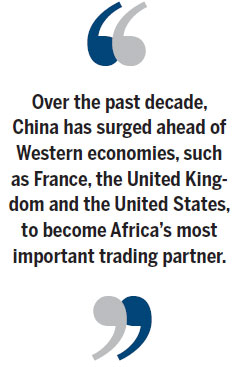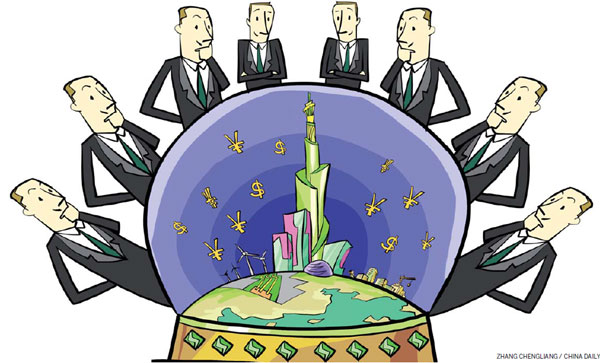3 reasons why China will continue to grow
Updated: 2014-08-22 10:15
By Dave Cote(China Daily Europe)
|
|||||||||||

Worries about a slowdown must be tempered by long-term trends that make expansion sustainable
Over the past three decades, China has been at the center of global economic growth and excitement, especially as host of the spectacular Beijing Olympics and Shanghai World Expo. Though China still has a number of issues to deal with (corruption, wealth disparity, state-owned enterprises and pollution, to name a few), it has already shown tremendous capability to address them and evolve its system.
At current growth rates, in about 25 years China will be the world's largest economy but will still have a relatively low GDP per capita, meaning more growth is possible.
Despite some slowing down and uncertainties in the economy, I believe there are at least three significant forces that will fuel China's future growth: China's going urban, going green, and going out. These factors will have a substantial influence on China's economic and industrial growth for a long time.
Going urban
In the three decades since economic liberalization began, China's urban population has expanded by more than 500 million, the equivalent of the United States plus three Britains. China's cities, already home to more than half the country's people, are still growing fast. By 2030, Chinese cities will be home to about 1 billion people - about 70 percent of China's population.
As more and more people move into the cities, a lot more construction and infrastructure will be needed. By 2030, China will demolish more than half of its existing residential housing and will need 40 billion square meters of new residential and commercial space.

China will also add approximately 170 new mass transit systems and 55 major airports during that same timeframe. This creates enormous demand for urbanization-enabling technologies such as sophisticated aviation and transportation infrastructure, smart grid solutions, building products, and related software and control systems.
Cities also need to be productive and economically dynamic. Businesses therefore must increasingly be better, faster, and more efficient. That need will generate strong demand for wireless and scanning technologies that can be used in both commercial and industrial applications.
China's urbanization will also create opportunities in residential markets. We expect to see the emergence of a gigantic market of 1 billion urban spenders as the country's middle class continues to expand. In fact, we expect that the fiercest competition will be selling to the middle class.
These increasingly affluent Chinese households will expect more innovative, technology-intensive home products that are high quality and moderately priced, such as water and air purifiers, humidifiers, fire alarms, and video door phones.
Going green
Pollution continues to be one of China's toughest challenges. Last year, Beijing's air on average was almost 10 times more polluted than levels considered safe. The World Bank says that 16 of the world's 20 most-polluted cities are in China.
China may be the world's worst polluter but it's also the world's largest investor in green energy. As China accelerates its efforts to address its environmental challenges, it will have a big impact on the environment and the world economy.
In clean energy and energy efficiency, China could consider using green fuels to power cars, ships and aircraft. There is huge potential in this area. Other examples include turbochargers that allow a small engine to perform like a large one, using 25 percent less fuel and generating 25 percent less emissions; homes and buildings with improved heating, ventilation and air conditioning controls and thermostats, allowing them to save 20-30 percent of the energy they use; and new air traffic control systems that can save 10-15 percent of the energy planes use in air travel.
To address the growing concerns about personal safety and health in China in the face of environmental pollution, we can also see the potential demand for personal protection equipment, sensing and controls, and security technologies for buildings, homes and industries.
China's environmental problems create an enormous and exciting basis for additional economic growth and opportunities for companies, like Honeywell, to innovate, collaborate and grow. Thanks to the scale and speed needed, China is likely to become a global leader in going green.
Going out
The first wave of China's opening up over the past three decades has featured foreign companies and investment pouring into China. In recent years, we have witnessed China's businesses, capital and people going out, especially to other emerging markets. This is a trend I expect will continue.
Over the past decade, China has surged ahead of Western economies, such as France, the United Kingdom and the United States, to become Africa's most important trading partner. About five years ago, China and the Association of Southeast Asian Nations kicked off the world's largest free trade area. Earlier this year, China and Central Asian countries proposed to build an economic belt along the Silk Road, a trans-Eurasian project from the Pacific Ocean to the Baltic Sea.
In the process of going out, dynamic domestic players and focused multinationals are helping China churn out a growing number of innovative products and services for the rest of the world. The concept is simple. Traditionally, investments have either gone from the West to the West or from the West to the East. But that dynamic has been changing. Investments are now going south to south, often with a Chinese company making an investment in other high-growth regions.
On my most recent trip to China, I had the opportunity to meet with key leaders of Shanghai municipality. They followed up on my invitation and took a municipal government delegation to our office to tour our Honeywell Technology Experience and R&D labs. The cooperation we have witnessed from the Shanghai leadership and many other officials throughout China is further proof of the desire by the country's leadership to continue to grow in smart ways and change without sacrificing what has made Chinese culture so strong for so long.
In business and government, it's helpful to drive a common agenda by looking at what's going on outside of what we control. We know that everything is always evolving. If you're not evolving faster, your business or you are falling behind. If the world around you evolves or changes 4 percent a year and you don't change at all, at the end of 10 years, you have to change about 50 percent just to get back to even. That's a revolution and it's a lot harder to control.
Given that 95 percent of the world's population and more than 75 percent of global GDP is outside the US, it makes sense for us to "follow the growth" and China continues to be where the growth is.
I'm a big believer that China is the place to be now and for the long-term.
The author is chairman and CEO, Honeywell. The views do not necessarily reflect those of China Daily.

(China Daily European Weekly 08/22/2014 page10)
Today's Top News
Telegram good gesture from Pope to China
Japanese firms face $200m fine
Ice Bucket Challenge hits China
Gaza ceasefire talks collapsed
Heinz recalls four batches of infant food in China
WHO says Ebola has killed more than 1,200
Japan looking to buy more stealth fighters
2 Air Force jets collide in Italy, 4 airmen missing
Hot Topics
Lunar probe , China growth forecasts, Emission rules get tougher, China seen through 'colored lens', International board,
Editor's Picks

|

|

|

|

|

|





